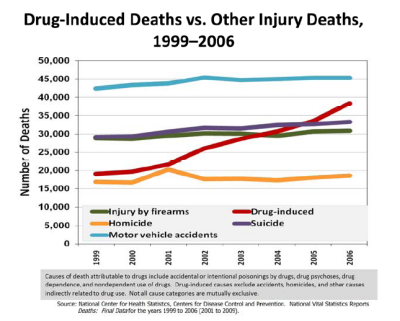A Balanced, Collaborative Approach to Reducing Drug Use and Its Consequences
For a year, National Drug Control Policy Director Gil Kerlikowske, Deputy Director Tom McLellan, and various Federal agencies worked to develop President Obama’s first National Drug Control Strategy. This Strategy, published in May, reflects a comprehensive approach to reducing drug use and its consequences.
Endorsing a balance of prevention, treatment, and law enforcement, the Strategy calls for a 15 percent reduction in the rate of youth drug use over five years. It also seeks similar reductions in chronic drug use and drugrelated consequences, such as drugged driving and overdose deaths. Drug-induced deaths have risen dramatically compared to other categories of death due to injuries (see chart). The Administration is requesting $15.5 billion in anti-drug spending for FY 2011.
The Strategy, a collaborative effort involving dozens of agencies, departments, Members of Congress, State and local organizations, and the American people, relies on experience and science-based evidence to reduce drug use and its consequences in the United States. Its implementation is a shared responsibility, supported by the Office of National Drug Control Policy (ONDCP) and its interagency partners.
The input received by ONDCP resulted in the following objectives:
Strengthen Efforts to Prevent Drug Use in Our Communities
Preventing drug use before it begins is a cost-effective, common-sense way to build safe and healthy communities.
Seek Early Intervention Opportunities in Health Care
Substance abuse costs society billions of dollars every year, with most of these funds expended on avoidable, catastrophic consequences of addiction, rather than on early intervention before the problem becomes severe. Integrating substance abuse services into general health care is cost effective and saves lives.
Integrate Treatment for Substance Use Disorders into Health Care, and Expand Support for Recovery
For millions of Americans, substance use progresses to a point where brief interventions are not sufficient to promote recovery. Addiction treatment can be a critical – even lifesaving – resource in such situations, but only if it is readily available and of high quality. Making recovery possible is, therefore, key to effective drug control.
Break the Cycle of Drug Use, Crime, Delinquency, and Incarceration
Drug use is often interwoven with criminal and delinquent behavior that disrupts family, neighborhood, and community life in fundamental and long-lasting ways. The criminal justice system plays an important role, therefore, in reducing drug use and its consequences.
Disrupt Domestic Drug Trafficking and Production
Drug trafficking organizations move large quantities of illicit drugs into the United States and distribute them throughout the Nation. These same groups, at times working through street and prison gangs, employ criminal networks that send the illicit proceeds of the drug trade – along with an array of weapons – across our borders. This trade imposes enormous negative consequences on the safety, health, and security of our citizens.
Strengthen International Partnerships
The United States is one of the world’s most lucrative markets for illegal drugs. It is both our responsibility, and in our best interest, to work collaboratively with our international partners to reduce the global drug trade. These efforts must include traditional supply control, as well as technology transfer of demand-reduction knowledge and programs to all parts of the world.
Improve Information Systems for Analysis, Assessment, and Local Management
Science should help inform policy and rigorously evaluate its effects. This can be possible only with near real-time information on drug use patterns, associated problems, and the results of previously implemented policies.
Download PDF
